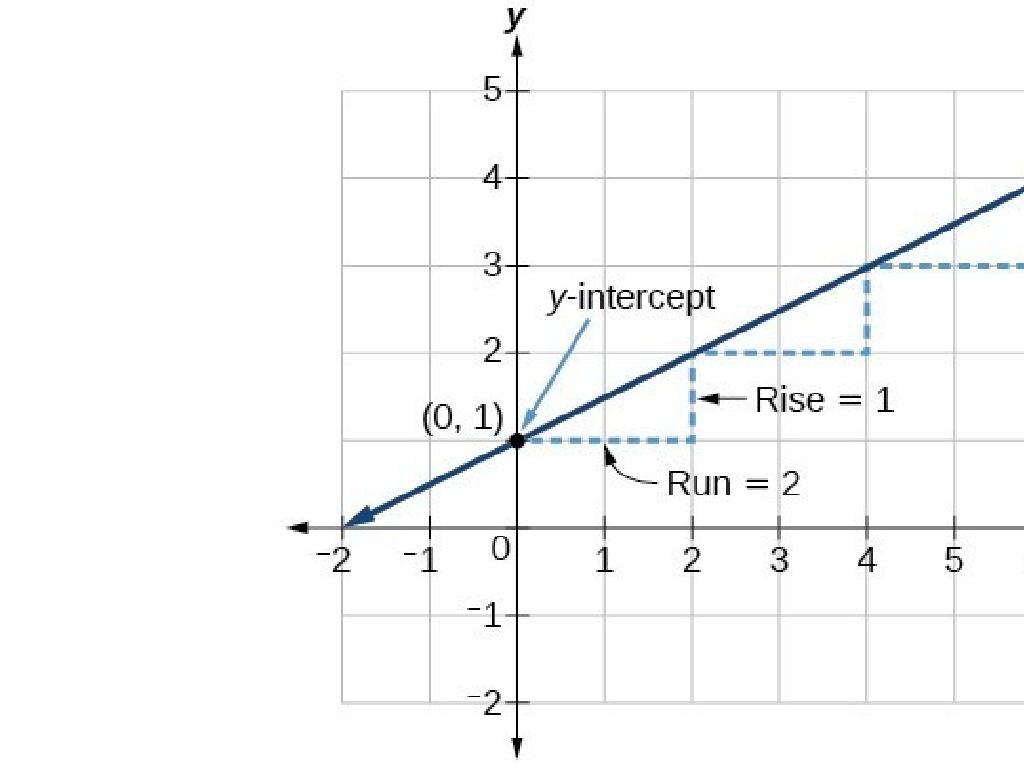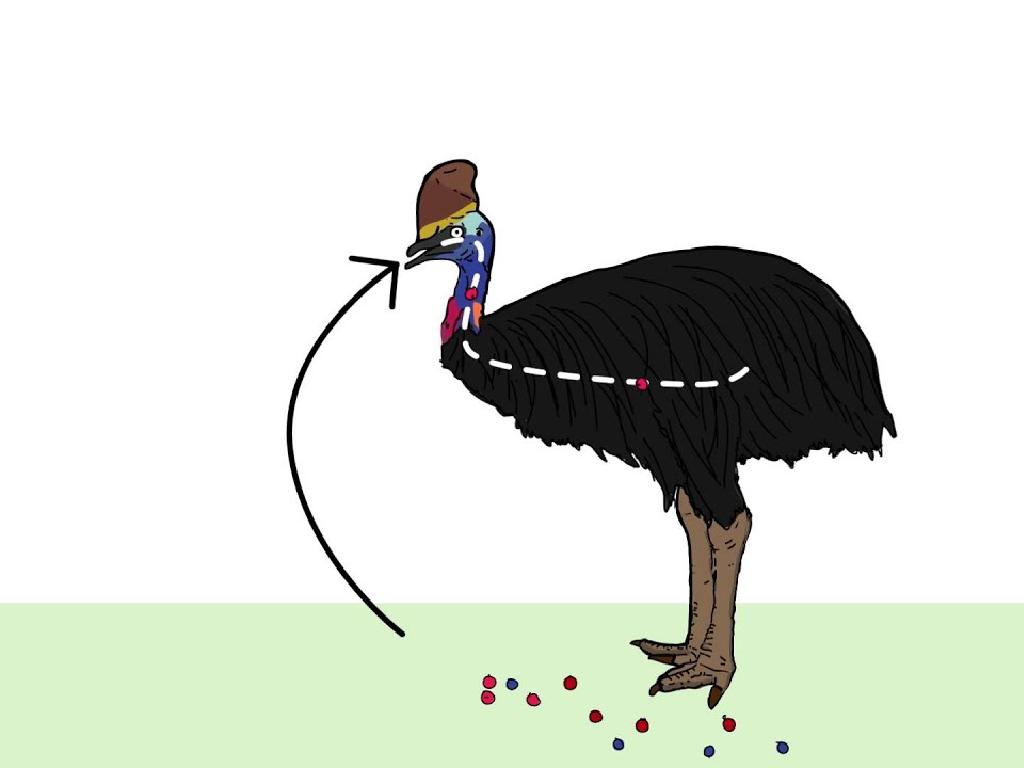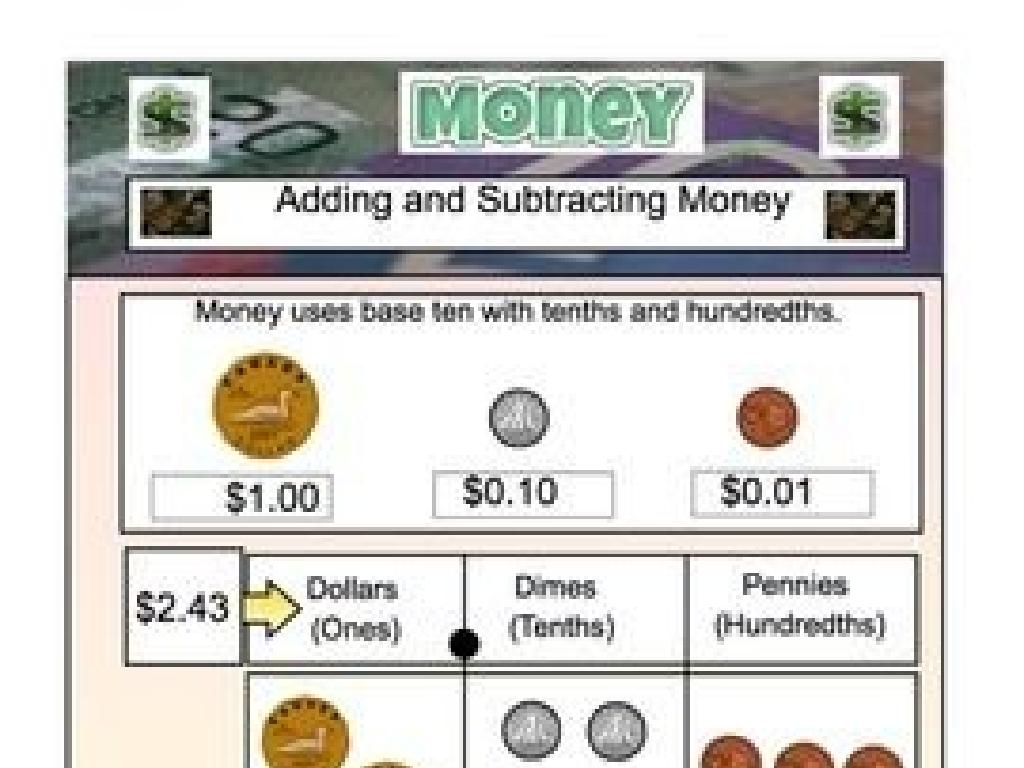Multiply And Divide Rational Numbers
Subject: Math
Grade: Seventh grade
Topic: Operations With Rational Numbers
Please LOG IN to download the presentation. Access is available to registered users only.
View More Content
Welcome to Rational Numbers
– Define rational numbers
– Numbers that can be expressed as a fraction a/b, where a and b are integers and b is not zero.
– Examples of rational numbers
– 1/2 (half), 3/4 (three quarters), -8/3 (negative eight thirds)
– Rational numbers in daily life
– Used in cooking, budgeting, and measuring
– Practice multiplying and dividing
|
This slide introduces students to the concept of rational numbers, which are any numbers that can be expressed as the quotient or fraction of two integers. Provide clear examples of rational numbers, both positive and negative, to illustrate the concept. Emphasize the relevance of rational numbers in everyday life, such as in recipes for cooking, when managing finances, or in construction when measuring materials. Conclude with the importance of understanding how to multiply and divide these numbers, as it’s a skill they will use frequently in various real-life situations. Encourage students to think of their own examples of rational numbers and how they are used in daily activities. The next part of the lesson will involve practicing multiplication and division with these numbers to solidify their understanding.
Multiplying Rational Numbers
– Understanding multiplication of rationals
– Multiplication combines groups of rational numbers.
– Rules for multiplying rational numbers
– Same signs multiply to positive, different signs to negative.
– Multiplying positive & negative rationals
– For example, multiplying 3/4 by -2/3 results in -1/2.
– Example walkthrough
– Let’s multiply 3/7 by -2/5 step by step.
|
When we multiply rational numbers, we’re essentially combining multiple groups of these numbers. It’s important to remember the rules regarding the signs: if we multiply two rational numbers with the same sign, the result is positive; if the signs are different, the result is negative. Use examples to illustrate these rules, such as multiplying a positive fraction by a negative fraction. Walk through an example step by step, showing how to multiply the numerators and denominators separately and then simplify the result if possible. This will help students understand the process and apply it to different problems.
Multiplying Rational Numbers
– Multiply two positive fractions
– Example: 1/2 * 3/4 = 3/8. Multiply numerators and denominators.
– Multiply a positive and a negative fraction
– Example: 2/5 * -4/7 = -8/35. The product is negative.
– Multiply two negative fractions
– Example: -1/3 * -3/5 = 1/5. Negative * Negative = Positive.
|
This slide focuses on teaching students how to multiply rational numbers, specifically fractions. Start with multiplying two positive fractions, ensuring students understand to multiply the numerators together and the denominators together. Then, introduce multiplying a positive fraction with a negative one, highlighting that the result is negative. Lastly, explain that the product of two negative fractions is positive. Use the examples provided to illustrate each case. Encourage students to practice with additional examples and remind them of the rules for determining the sign of the product.
Dividing Rational Numbers
– Understanding division of rationals
– Division is finding how many times a number is contained within another.
– Rules for dividing rational numbers
– Keep, Change, Flip: Keep the first number, change division to multiplication, flip the second number.
– Steps for positive & negative numbers
– To divide, change the sign of the divisor if it’s negative and follow the rules.
– Practice with examples
– Let’s divide 1/2 by -1/4 and -3/5 by 2/7 together.
|
This slide introduces the concept of dividing rational numbers, which includes both positive and negative fractions and decimals. Start by explaining the meaning of division in the context of rational numbers. Emphasize the ‘Keep, Change, Flip’ rule, which is a simple way to remember the steps for dividing fractions. Provide a step-by-step walkthrough of dividing a positive rational number by a negative one, and vice versa, to illustrate the rules. Include practice examples to solidify understanding. Encourage students to work through the examples provided and to come up with similar problems to solve.
Dividing Rational Numbers
– Divide two positive fractions
– Example: 1/2 ÷ 2/3 = 1/2 x 3/2 = 3/4
– Divide a positive by a negative
– Example: 3/5 ÷ -2/7 = 3/5 x -7/2 = -21/10 or -2.1
– Divide two negative fractions
– Example: -4/9 ÷ -2/3 = -4/9 x -3/2 = 12/18 = 2/3
– Understanding quotient signs
|
This slide aims to demonstrate how to divide rational numbers, specifically fractions. Start with two positive fractions to establish the rule of multiplying by the reciprocal. Then, introduce a negative to show how the sign of the quotient changes. With two negatives, students will see that the negatives cancel out, resulting in a positive quotient. Emphasize the importance of understanding how the signs of the numbers affect the outcome. Encourage students to practice with additional examples and to pay close attention to the signs when multiplying or dividing rational numbers.
Practice Problems: Multiplying & Dividing Rational Numbers
– Solve a multiplication problem
– Example: (3/4) x (2/3) = ?
– Work through a division problem
– Example: (5/6) ÷ (1/2) = ?
|
This slide is designed for a collaborative classroom activity where students will practice multiplying and dividing rational numbers. For the multiplication problem, guide students through the process of finding the product of two fractions, ensuring they understand how to multiply numerators and denominators. For the division problem, demonstrate how to divide one fraction by another by multiplying by the reciprocal of the divisor. Encourage students to simplify their answers. Provide additional problems for students to solve independently, and then review as a class to reinforce the concepts.
Class Activity: Rational Numbers Relay
– Form small groups for relay
– Solve multiplication problems
– Use rational numbers in equations
– Solve division problems
– Include both integers and fractions
– First to finish correctly wins!
|
This activity is designed to encourage teamwork and reinforce the concept of multiplying and dividing rational numbers. Divide the class into small groups and provide each group with a set of problems involving both multiplication and division of rational numbers. Ensure the problems vary in difficulty and include both integers and fractions. The first group to correctly complete all problems wins. As a teacher, circulate to offer guidance and check answers. Possible variations of the activity could include a mix of word problems, timed challenges, or incorporating negative numbers to increase complexity.
Wrapping Up: Multiplication & Division of Rational Numbers
– Review of multiplying/dividing rational numbers
– Mastery of operations is crucial
– Understanding these concepts is key for advanced math topics.
– Homework: Rational Numbers worksheet
– Complete the provided worksheet to practice.
– Practice makes perfect!
|
As we conclude today’s lesson, it’s important to recap the steps for multiplying and dividing rational numbers. Emphasize the importance of mastering these operations as they are foundational for higher-level math. For homework, students are assigned a worksheet that includes a variety of problems to ensure they get ample practice. Encourage students to attempt each problem and remind them that making mistakes is a part of the learning process. During the next class, we will review the homework answers and clarify any doubts, reinforcing their understanding of the topic.





